We are a full service dental practice
We focus on treating our patients with sincere, personalized care.
Our top priority is to offer the best patient education so you fully understand your oral health,
and how we can best care for it both in the office and in your home.
We have long standing relationships with a great network of specialists if you need more complex services out of our practice scope. We only refer to specialists who share our same practice philosophies.
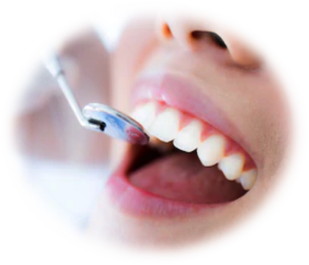
Preventative
Care
Preventative treatment is the most important factor in overall oral health. Preventative treatment includes regular check up x-rays, exams, and cleanings, along with proper home oral care.
Preventative treatment is the most important factor in overall oral health. Preventative treatment includes regular check up x-rays, exams, and cleanings, along with proper home oral care.
Our practice provides the highest-quality services for restoring teeth that have been damaged by dental cavities and gum disease. Our primary goal for our patients is to achieve and maintain optimum oral health through advances in techniques, technologies and by maintaining their scheduled dental exams. Dental issues are far easier to address early on, and complexity builds as treatment is delayed.
Teeth Cleaning
You should get your teeth cleaned at minimum every 6 months. Some people require more frequent cleanings every 3-4 months if they have a history of gum disease. It is important to get regular cleanings because even the best home care cannot reach all areas around teeth and underneath the gums that need cleaning. Our office provides a convenient text reminder service so you always know when you are due.
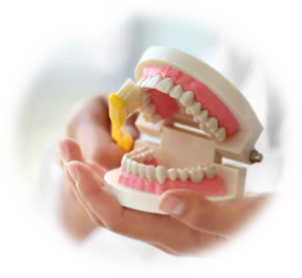
Clinical Exam & Oral Cancer
Screening + X-rays
You should have routine x-rays and check up exams to stay current with your dental health. It is so important to take care of problems early on when they can be treated easily. Dental problems often become complicated and more advanced if left untreated over long periods of time.
You should have routine x-rays and check up exams to stay current with your dental health. It is so important to take care of problems early on when they can be treated easily. Dental problems often become complicated and more advanced if left untreated over long periods of time.
A full set of X-rays, called an “FMX” is taken on your first visit, and every 5 years following. This full set includes every angle of your teeth, roots, and jawbone. Every 2 years, check up x-rays or “bitewings” are taken. These x-rays show the areas in between the teeth, where cavities often form and cannot be seen visually.
Oral Cancer Screening
Oral cancer screenings are done during every check up and cleaning. It is important to have all tissues in the mouth checked because most people do not notice the early stages of suspicious lesions. Often times suspicious lesions are benign and not painful, and can go undetected for long periods of time. Catching lesions early is best for long-term prognosis.
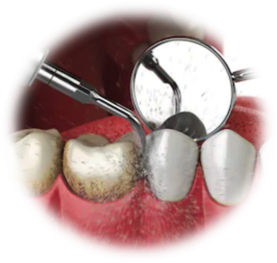
Periodontal (gum) Treatment
You should get your teeth cleaned at minimum every 6 months. Some people require more frequent cleanings every 3-4 months if they have a history of gum disease. It is important to get regular cleanings because even the best home care cannot reach all areas around teeth that need cleaning. Our office provides a convenient text reminder service so you always know when you are due.
You should get your teeth cleaned at minimum every 6 months. Some people require more frequent cleanings every 3-4 months if they have a history of gum disease. It is important to get regular cleanings because even the best home care cannot reach all areas around teeth that need cleaning. Our office provides a convenient text reminder service so you always know when you are due.
Regular cleanings VS deep cleanings
A Prophylaxis or “regular cleaning” is only an option for patients who do not have any signs of gum disease. If there are signs of disease or areas of the gums that are being damaged by excess plaque and calculus build up, Scaling and root planning or a “deep cleaning” will be needed.
Signs of gum disease:
• Bleeding gums
• Red and inflamed gums
• Significant plaque and tartar or calculus build up around teeth
• Bad breath
• Larger spaces or gaps in between teeth
• Receding gums
How gum disease happens…
Gum disease begins with plaque and calculus build up. Plaque is the bacteria we brush off of our teeth daily. When areas of plaque are missed, the minerals in our saliva calcify it and turn it into calculus. The presence of calculus is the initiator in the development of gum disease. Once calculus is present, it will remain in your mouth until a dental hygienist removes it. These pieces of calculus are essentially barnacles on your teeth. Even with the best brushing and flossing techniques you will not be able to remove it.
Calculus is detrimental because it begins the cycle of gum disease. The gums and underlying bone do not want to be near the calculus stuck on you teeth, so they will actually recede away from the calculus through your body’s natural immune response. This is one of the ways gum recession and accompanying bone loss occurs. Bone loss is the movement of your jawbone away from your teeth, and bone loss creates larger spaces in between the teeth where plaque and calculus can continue to accumulate and spread deeper underneath your gums. This is why foul odors and bleeding occur. Damaging amounts of calculus takes years to build up, but once it begins damaging your gums and bone levels, it can be complicated to regain optimal health.
Unfortunately, the bone levels aren’t able to grow back on their own, and long periods of neglect can lead to the loosening and loss of teeth. This highlights why regular cleanings are so critical to help support your at home care in preventing gum disease.
Unfortunately, gum disease is so prevalent because it does not create any pain or discomfort, aside from bleeding and inflamed gums. For this reason many people neglect their gum health. It is important to recognize these red flags your gums are trying to signal to properly clean and regain optimal oral and overall health.
There is clinical evidence proving gum disease is linked to many health issues such as diabetes, heart disease, Alzheimers, and low birth weight in newborns.
Keeping your gums healthy is vital in maintaining your overall health!
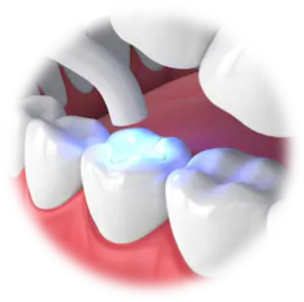
Fillings
A cavity is a hole within your tooth created by harmful bacteria. If a cavity is left to grow, it can progress and breakdown much of your tooth. If left untreated it can eventually reach the nerve located in the center of your tooth. To treat a cavity, all affected tooth must be removed and then “filled”. Not all cavities can be restored with fillings.
A cavity is a hole within your tooth created by harmful bacteria. If a cavity is left to grow, it can progress and breakdown much of your tooth. If left untreated it can eventually reach the nerve located in the center of your tooth. To treat a cavity, all affected tooth must be removed and then “filled”. Not all cavities can be restored with fillings. There should always be more natural tooth than filling present for a predictable successful outcome. When cavities become very large, a filling will not suffice to repair the tooth.
Apart from restoring cavities, fillings are also used to repair cracked or broken teeth and teeth that have been worn down from traumatic habits (nail-biting or tooth grinding).
Filling Process
First, local anesthetic is used to numb the tooth to be filled. Second, the cavity is removed using a dental hand piece, commonly known as a drill. Third, once all decayed tooth is removed and only healthy tooth remains, the missing area is filled with a filling. Lastly, the filling is shaped and polished to perfection and your bite is checked to make sure it is accurate.
Fillings can last many years, but often do require replacement over time.
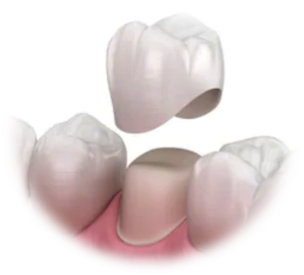
Crowns
A crown is a permanent covering that fits over an original tooth that is either decayed, damaged or cracked. Crowns are made of a variety of different materials such as porcelain, gold, acrylic resin, Zirconia or a mix of these materials.
A crown is a permanent covering that fits over an original tooth that is either decayed, damaged or cracked. Crowns are made of a variety of different materials such as porcelain, gold, acrylic resin, Zirconia or a mix of these materials.
A crown requires 2 visits. The first visit is the preparation of the tooth, where all cavity, cracks, or damaged portions are removed. An impression or scan of your tooth is taken and sent to the lab where your crown is fabricated. The crown will be ready upon your return for the second visit, where it is permanently cemented.
How to care for a crown
Once the procedure is completed, proper dental hygiene, including daily brushing and flossing, is required to maintain healthy, bacteria-free teeth, gums and crowns. It is important to brush in circular motions, so you can properly clean where the crown meets the gum line. Given proper care, your crowns can last many years or even a lifetime.

Veneers
Veneers are thin, semi-translucent “shells” typically attached to your front teeth. Veneers are customized from porcelain material and permanently bonded to your teeth. Veneers are a great minimally invasive dental procedure to improve the appearance of your smile.
Veneers are thin, semi-translucent “shells” typically attached to your front teeth. Veneers are customized from porcelain material and permanently bonded to your teeth. Veneers are a great minimally invasive dental procedure to improve the appearance of your smile.
Common problems that veneers are used for:
○ Spaces between the teeth
○ Broken or chipped teeth
○ Unsightly, stained or discolored teeth
○ Permanently stained or discolored teeth
○ Crooked or misshapen teeth
Veneers are a great aesthetic solution to your smile that may even help you avoid orthodontic treatment. Subtle changes to your smile can be achieved with veneers, and in most cases, veneer application is completed in only two office visits.
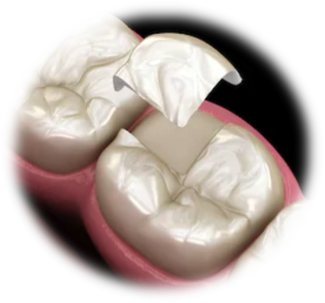
Inlays and Onlays
Inlays and onlays are exciting advancements in dentistry. These can easily be described as “partial crowns”. Often times, there is an area of tooth that must be treated; yet much of the tooth is still healthy. Inlays and onlays provide an option when an area is too large to restore with a filling, but still allows for an amount of natural tooth conservation. Essentially, inlays and onlays allow conservation of as much healthy tooth as possible.
Inlays and onlays are exciting advancements in dentistry. These can easily be described as “partial crowns”. Often times, there is an area of tooth that must be treated; yet much of the tooth is still healthy. Inlays and onlays provide an option when an area is too large to restore with a filling, but still allows for an amount of natural tooth conservation. Essentially, inlays and onlays allow conservation of as much healthy tooth as possible.
Inlays vs Onlays
There is a difference between inlays and onlays. Molars, which are your back teeth, have peaks and valleys in them. These peaks are called “cusps”. If a cusp is missing, too thin, or decayed out, and it needs to be incorporated in the restoration, then this is termed an “Onlay”. If the cusps are strong enough after removing the damaged tooth structure, and can be left alone, then this is termed an “Inlay”.

Bridges
A bridge is a dental restoration that fills the space of a missing tooth. Bridges and implants are the only two permanent options for replacing missing teeth. Bridges have a specific requirement: there must be neighboring natural teeth both in front and behind the missing tooth space. Although bridges are long lasting, successful, permanent options, they do require extra hygienic care. Bridges can require replacement if any of the teeth involved become problematic.
A bridge is a dental restoration that fills the space of a missing tooth. Bridges and implants are the only two permanent options for replacing missing teeth. Bridges have a specific requirement: there must be neighboring natural teeth both in front and behind the missing tooth space. Although bridges are long lasting, successful, permanent options, they do require extra hygienic care. Bridges can require replacement if any of the teeth involved become problematic.
A bridge may be necessary to prevent:
• Shifting of the neighboring teeth that can lead to bite (occlusion) problems and/or jaw problems and resultant periodontal disease.
• Bridges safeguard the integrity of existing teeth and help maintain a healthy, vibrant smile.
There are three main types of bridges, namely:
• Fixed bridge: most common and consists of 3 connecting crowns. Two of the crowns hold onto the teeth that neighbor the missing space, and the third crown fills the space of your missing tooth completely.
• “Maryland” bridge: commonly used to replace missing front teeth and consists of a filler crown that is attached to a natural tooth neighboring the missing space only on the backside.
• Cantilever bridge: often used when there are teeth on only one side. A typical three-unit cantilever bridge consists of two crowned teeth positioned next to each other and a filler tooth that is then connected to the two crowned teeth, extending behind into the missing tooth space or end. These types of bridges are often not recommended due to the extreme undesirable forces placed on the “cantilever” portion of the bridge.
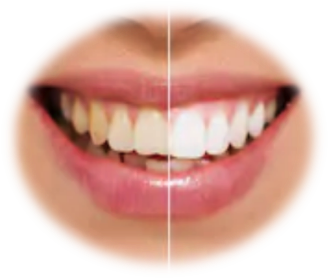
Whitening
Teeth whitening has become increasingly popular and it is one of the most requested services in our office. Patients are more esthetically focused on their smiles, and we are happy to provide numerous options for teeth whitening. Changes in the shade of your teeth can be caused by everyday factors such as food and beverages consumed (coffee, tea, soda, wine). Other factors for discoloration include childhood medications or illnesses, tobacco use or improper oral hygiene.
There is a growing consumer market focused on whiter teeth, and the reality is over-the-counter, “too good to be true” solutions typically don’t provide lasting results.
Teeth whitening has become increasingly popular and it is one of the most requested services in our office. Patients are more esthetically focused on their smiles, and we are happy to provide numerous options for teeth whitening. Changes in the shade of your teeth can be caused by everyday factors such as food and beverages consumed (coffee, tea, soda, wine). Other factors for discoloration include childhood medications or illnesses, tobacco use or improper oral hygiene.
There is a growing consumer market focused on whiter teeth, and the reality is over-the-counter, “too good to be true” solutions typically don’t provide lasting results.
We are trained professionals using only industry-approved methods. One of the methods used by our practice is a gentle hydrogen-peroxide gel-activated solution. This process will whiten your entire smile in just one visit.
Whitening options:
• 1 hour Kör Whitening bleach session: Provides the best, longest lasting results using clinical grade 34% hydrogen peroxide gel solution
• Custom bleach trays used at home with clinical grade whitening gel: A great follow up option after the 1 hour Kör bleach session. These custom trays allow for touch up whitening whenever you see fit. Clinical grade 9% or 14% Hydrogen peroxide gel can also be continuously purchased in our office, making the custom trays something you can utilize for a lifetime
• 20 minute Sinsational Smile session: The quickest form of whitening, using 25% Hydrogen peroxide gel and an illuminating blue light. This option is most ideal for a simple, easy, and quick touch up brightening of your smile
Sensitivity after Whitening
Sensitivity after whitening is very common. Intensity ranges, but often times this is temporary and will last for a few days to weeks. Fluoride placement after whitening is helpful in restoring optimal enamel strength. Usually, whitening treatments using lights lead to more post-op sensations and sensitivity. Whenever possible, opt for whitening treatments using gels to achieve better penetration into the teeth, and less post-op sensations and sensitivity.
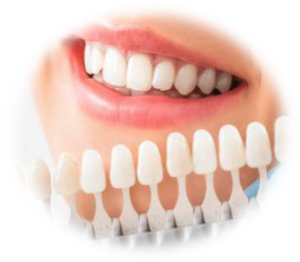
Cosmetic Dentistry
Cosmetic dentistry encompasses any treatment that aims to change or elevate your smile and is typically an elective treatment. As patients are becoming more esthetically focused on their teeth, we are pleased to provide numerous options to achieve your optimal and desired smile.
Teeth whitening, Cosmetic Composite Bonding, Crowns, Veneers, and Invisalign all classify as cosmetic dentistry treatments
Cosmetic dentistry encompasses any treatment that aims to change or elevate your smile and is typically an elective treatment. As patients are becoming more esthetically focused on their teeth, we are pleased to provide numerous options to achieve your optimal and desired smile.
Teeth whitening, Cosmetic Composite Bonding, Crowns, Veneers, and Invisalign all classify as cosmetic dentistry treatments
Composite Bonding
Bonding is a common solution for:
• Fixing or repairing chipped or cracked teeth
• Reducing unsightly gaps or spaces between teeth
• Hiding discoloration or faded areas on the tooth’s surface
As the name indicates, composite resin material, is bonded to your existing tooth. Unlike veneers or crowns, composite bonding removes little, if any, of the original tooth. Composite bonding has many advantages:
• It is a quick process, which typically lasts less than one hour
• It does not reduce the tooth’s original structure and is relatively inexpensive compared to other esthetic treatments
• Composite resins come in many different shades and provide better matching of shades to the natural color of your teeth
• Composite bonds, however, are not as durable and long-lasting as veneers and crowns and may need to be re-touched or replaced in the future
Composite bonds can stain more easily after years and therefore require proper care and regular cleaning. In order to ensure the longest possible duration of the bonding, composites should be brushed and flossed daily. Common staining elements include coffee, tea, tobacco, foods and candy.
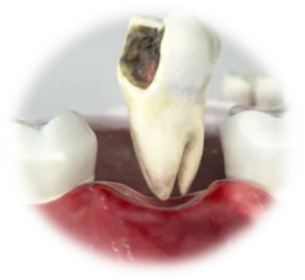
Simple Extractions
Unfortunately, sometimes teeth break or have cavities far too large to treat successfully, and they must be extracted. Many teeth can be extracted simply, but others are more complex and require a referral to an Oral surgeon.
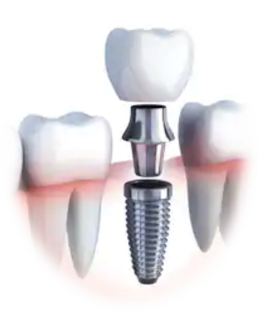
Implants
Dental implants are artificial tooth replacements that were first developed half a century ago by a Swedish scientist named Per-Ingvar Branemark. Implants arose from the patient’s need to secure loose-fitting dentures. Since the advent of the implant, engineering and enhancements have enabled dentists to expand the implant’s usefulness, including the replacement of missing or lost teeth.
Dental implants are artificial tooth replacements that were first developed half a century ago by a Swedish scientist named Per-Ingvar Branemark. Implants arose from the patient’s need to secure loose-fitting dentures. Since the advent of the implant, engineering and enhancements have enabled dentists to expand the implant’s usefulness, including the replacement of missing or lost teeth. Today, implant techniques provide a wide range of tooth replacement solutions including:
• Single Tooth Replacement
• Anterior Replacement
• Posterior Replacement
• Full Arch Replacement
Implants
There are many different implant systems, we typically work with Nobel Biocare, Straumann, Astra, and 3I Biomet.
An implant is a titanium post that mirrors the size of a patient’s root. The first step begins with an implant being placed into the jawbone under local anesthesia. The titanium is biocompatible, and over a period of 4 months, it becomes integrated into the patients jawbone. Once the healing process is completed and the implant is integrated into the jawbone, the patient returns to the dental office where the implant post is connected to a permanent crown. This process generally takes anywhere from four to eight months. The implant is often as strong or stronger than the patient’s original tooth, and the long term success rate is over 95%.
Implant As a Treatment Option
An implant is the closest thing you can get to a natural tooth. For this reason, it is the best treatment option for any missing tooth or teeth. It also stands on its own, and doesn’t require grinding down the neighboring teeth. The only limitation for an implant is the amount of bone surrounding it, so it is best to take care of missing spaces as soon as possible before bone loss occurs over time.
Post Implant Care
Although proper oral hygiene is always recommended for maintaining good dental health, it is especially important when a patient has a dental implant. Bacteria can attack sensitive areas in the mouth when teeth and gums are not properly cleaned, thus causing gums to become inflamed and jaw bones to gradually recede. Recession of the jawbone will weaken implants and eventually make it necessary for the implant to be removed. Patients are advised to visit their dentists at least twice a year to ensure the health of their teeth and implants. Dental implants can last for decades to a lifetime when given proper care.

Invisalign
If your smile is not where you want it to be, come in for a complimentary Invisalign consultation. We will discuss if Invisalign is right for you and we will show you a simulation of your final smile position using the scans we take.
If your smile is not where you want it to be, come in for a complimentary Invisalign consultation. We will discuss if Invisalign is right for you and we will show you a simulation of your final smile position using the scans we take.
The Invisalign Process:
Intra-oral scans taken of your teeth and bite using iTero to fabricate custom made Invisalign aligners to suit your unique treatment plan.
Aligners will make slight adjustments to your teeth positions and will follow the unique map planned for you.
New aligners are changed approximately every two weeks until treatment is finished and your smile alignment is perfect.
Benefits of Invisalign:
• Although most people want Invisalign for esthetics, other benefits include improved overall oral health and protection of teeth from wear and breakdown due to improper positions
• Invisalign is nearly invisible, so there isn’t any burden, embarrassment, and inconvenience of traditional braces
• Aligners are easily removable so you can easily take them out at mealtimes and brush and floss as you normally would
Most Invisalign cases are very straightforward but can make a world of difference.
Come see if Invisalign is right for you and regain that confidence of a perfect smile.

Snore Therapy
Snoring affects millions of people of all ages, both male and female. Oral appliance therapy is the most common treatment for the most severe snoring problems. Treatment procedures range from changing your sleep patterns to utilizing orthodontic-related appliances that help open the airways during sleep.
Snoring affects millions of people of all ages, both male and female. Oral appliance therapy is the most common treatment for the most severe snoring problems. Treatment procedures range from changing your sleep patterns to utilizing orthodontic-related appliances that help open the airways during sleep.
What causes snoring?
Snoring is caused by the vibrations of your soft and/or hard tissue palates; these vibrations occur because of increasingly narrow air passages. When air passes through these passages, a “flapping” sound occurs because the tissue is soft in nature. Surgery (to alleviate the snoring) is not always successful, however, because the sound may not originate from the soft palate; the snoring sometimes originates from tissues in the upper airway.
Common causes for snoring:
• Smoking
• Alcohol
• Health Problems
• Obesity
• Obstructed Nasal Passages – Deviated Septum
• Poor Muscle Tone of the Tongue
• Daytime Fatigue
• Sleep Apnea
• Hypothyroidism
• Allergies
Sleep Apnea
Loud snorers may have a more serious case of blocked air passages, known as obstructive sleep apnea syndrome (OSAS). In these cases, the blockage of air is so great that no air can get through, causing repeated awakenings throughout the night. Obstructive sleep apnea can contribute or lead to many other conditions, such as high blood pressure, stroke, heart attack and depression, so it is important to be diagnosed by a medical professional if you experience any sleep-related symptoms.
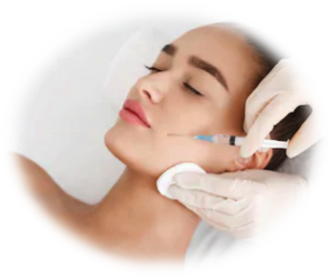
Botox
Botox is quickly becoming part of the modern dental practice due to its tremendous ability to help patients therapeutically, functionally, and cosmetically. While Botox certainly can be effectively used in a dental office for cosmetic wrinkle reduction, its most exciting uses in dentistry are therapeutic and protective.
Botox is quickly becoming part of the modern dental practice due to its tremendous ability to help patients therapeutically, functionally, and cosmetically. While Botox certainly can be effectively used in a dental office for cosmetic wrinkle reduction, its most exciting uses in dentistry are therapeutic and protective.
Botox can play an integral part in a comprehensive treatment plan for patients suffering from destructive parafunctional habits such as clenching and grinding. Unfortunately, these habits are involuntary, and typically occur mostly during sleep. Clenching and grinding are the result of hyperactive jaw muscles, and by targeting these muscles directly, Botox is able to limit the intensity of their force. This results in a reduction of their damaging effects, such as: jaw soreness and pain, headaches, chipped and flattened teeth and restorations, tooth sensitivity, gum recession and TMJ disorders.
While Botox is not a substitute for a nightguard, it is a helpful adjunctive treatment for patients who suffer from clenching and grinding and their aforementioned consequences. While nightguards can help protect your teeth, Botox treatment actually addresses the root of the problem. Realistically, patients are unable to wear their nightguards 24 hours a day, and simply wearing a nightguard will not cause a patient to stop clenching and grinding. With Botox treatment, patients will immediately experience less jaw tension, fewer headaches, reduced facial pain, and a noticeably slimmer appearance in the contour of their face where their muscle lies. The long-term benefits of Botox are just as remarkable, as treatment can help further protect the teeth reducing the occurrence of wear, cracks, chips, fractures, and sensitivity. Using Botox in conjunction with a nightguard will provide the optimal protection for your teeth, restorations, and gums.
Our goal is to utilize Botox in our practice as another tool for creating a healthy and beautiful smile for all patients. Botox is a great compliment to our cosmetic treatments, which include KOR whitening, Invisalign, veneers, and bonding.
Botox is an easy, non-invasive, relatively painless, side effect free treatment option for addressing dental related conditions and achieving full facial esthetics. Any effect of Botox is temporary, and roughly lasts 3 months. After this time, the Botox begins to break down and as muscles begin to regain full functional strength, both wrinkles and symptoms will start to return. This is an exciting proven treatment that we are eager to provide for our patients. We will offer Botox to treat jaw muscles, forehead lines, brow “frown” lines, crows feet around the eyes, and vertical lip lines. Using small, targeted injections of Botox will result in a smoother, softer, and more youthful overall look and smile.
We are excited to show you how Botox can improve your overall dental health and appearance!

